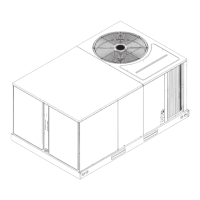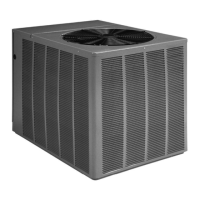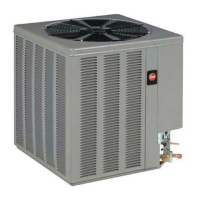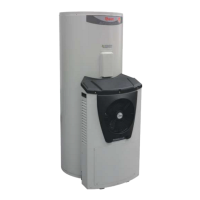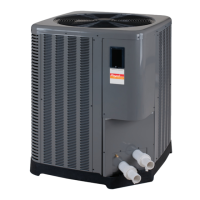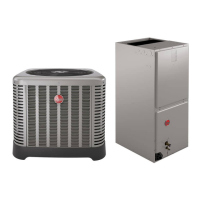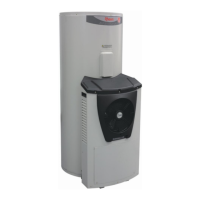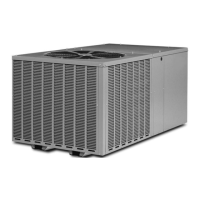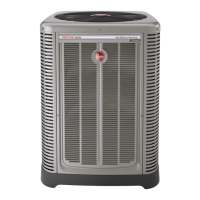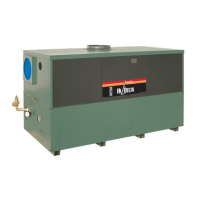10
4.0 INSTALLATION
4.3.3 Elevating Unit
WARNING:
Secure an elevated unit and
its elevating stand in order to prevent tipping. Failure to
do so may result in severe personal injury or death.
If elevating the unit, either on a at roof or on a slab,
observe the following guidelines.
If elevating a unit on a at roof, use 4” x 4”
[10.2 cm x 10.2 cm] or equivalent stringers positioned
to distribute unit weight evenly and prevent noise and
vibration.
Location
NOTICE:
DO NOT block drain openings
on bottom of unit.
DO NOT BLOCK
OPENINGS
IN BASE PAN
BASE PAD
(CONCRETE OR OTHER SUITABLE
MATERIAL)
ST-A1226-03-00
If unit must be elevated, secure unit and elevating
stand such that unit and/or stand will not tip over
or fall off. Keep in mind that someone may try to
climb on unit.
4.4 Refrigerant Line Set Selection
4.4.1 Replacing Existing Systems
To prevent failure of a new unit, the existing line set
must be correctly sized for the new unit and must
be cleaned or replaced. Care must be taken so
the expansion device is not plugged. For new and
replacement units, a liquid line lter drier must be
installed and the line set must be properly sized.
Test the oil for acid. If it tests positive for acid, a
suction line lter drier is mandatory.
IMPORTANT:
When replacing an
R-22 unit with an R-410A unit, either replace
the line set or ensure that residual mineral oil is
drained from existing lines including oil trapped in
low spots
ELEVATE ABOVE
ANTICIPATE HIGH
SNOW FALL
4.4.2 Line Set Length and Fitting Losses
ƋƵŝǀĂůĞŶƚ>ĞŶŐƚŚĨŽƌ&ŝƚƚŝŶŐƐ;ĨƚͿŵ
>ŝŶĞ^ŝnjĞ
;ŝŶͿŵŵ
ϵϬΣ^ŚŽƌƚ
ZĂĚŝƵƐ
ůďŽǁ
ϵϬΣ>ŽŶŐ
ZĂĚŝƵƐ
ůďŽǁ
ϰϱΣ
ůďŽǁ
^ŽůĞŶŽŝĚ
sĂůǀĞ
ŚĞĐŬ
sĂůǀĞ
^ŝƚĞ
'ůĂƐƐ
&ŝůƚĞƌ
ƌŝĞƌ
ϯϴϵϱϯ ϭϯϬϰϬ ϬϴϬϮϰ ϬϯϬϬϵ ϲϭϴϯ ϰϭϮϮ ϬϰϬϭϮ ϲϭϴϯ
ϭϮϭϮϳϭ ϭϰϬϰϯ ϬϵϬϮϳ ϬϰϬϭϮ ϵϮϳϰ ϱϭϱϮ ϬϲϬϭϴ ϲϭϴϯ
ϱϴϭϱϴϴ ϭϱϬϰϲ ϭϬϯϬ ϬϱϬϭϱ ϭϮϯϲϲ ϲϭϴϯ ϬϴϬϮϰ ϲϭϴϯ
ϯϰϭϵϬϱ ϭϵϬϱϴ ϭϯϬϰϬ ϬϲϬϭϴ ϭϰϰϮϳ ϳϮϭϯ ϬϵϬϮϳ ϲϭϴϯ
ϳϴϮϮϮϯ ϮϯϬϳϬ ϭϱϬϰϲ ϬϳϬϮϭ ϭϱϰϱϳ ϴϮϰϰ ϭϬϯϬ ϲϭϴϯ
ϭͲϭϴϮϴϱϴ ϮϳϬϴϮ ϭϴϬϱϱ ϬϵϬϮϳ ϮϮϲϳϭ ϭϮϯϲϲ ϭϱϬϰϲ ϲϭϴϯ
Table 1
Refrigerant tubing is measured in terms of actual
length and equivalent length. Actual length is used
for refrigerant charge applications. Equivalent
length takes into account pressure losses from
tubing length, ttings, vertical separation, accesso-
ries, and lter driers. The table below references
commonly used equivalent lengths.

